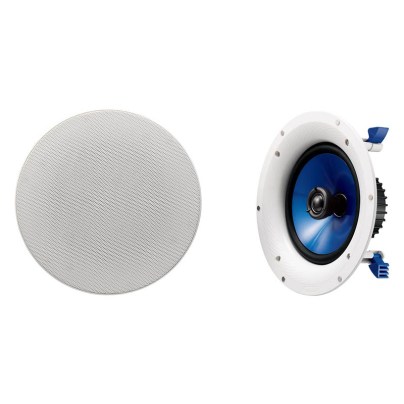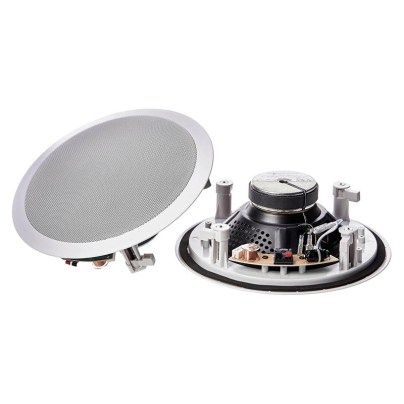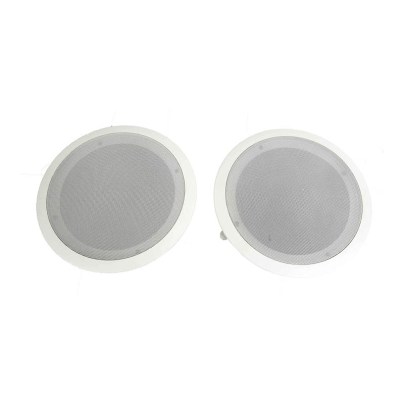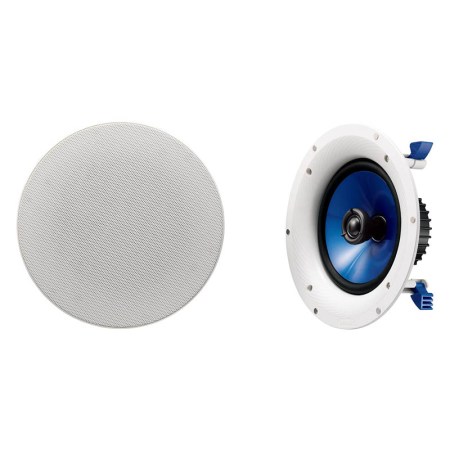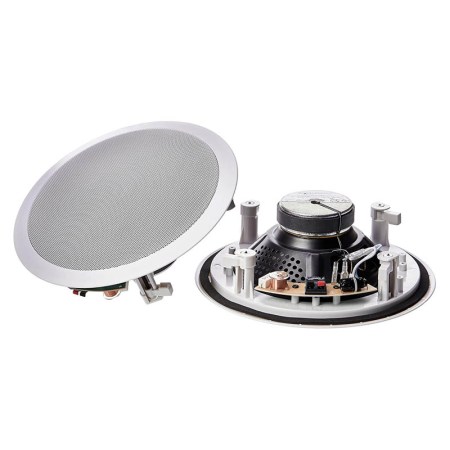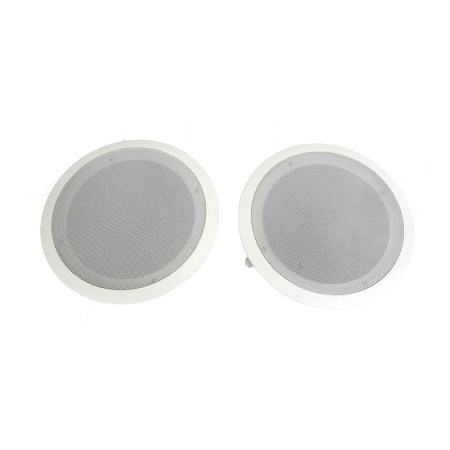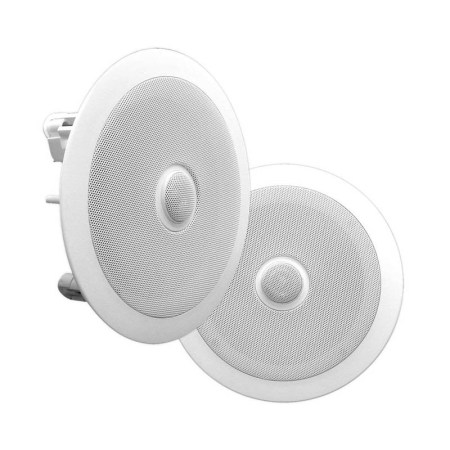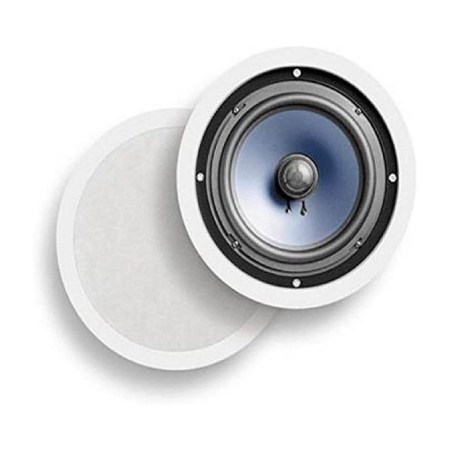We may earn revenue from the products available on this page and participate in affiliate programs. Learn More ›
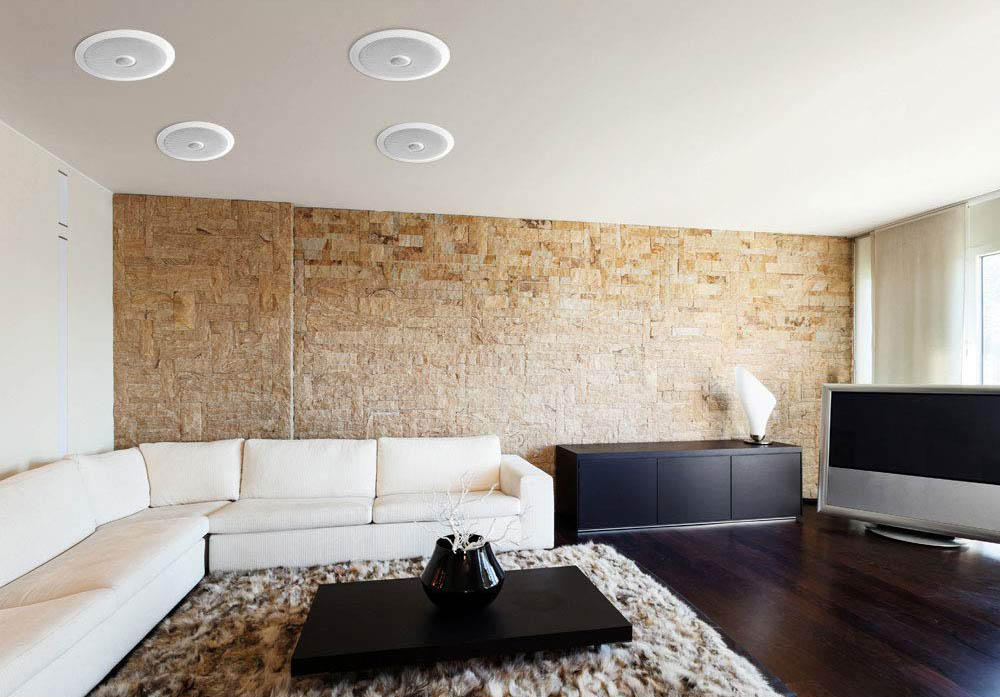
Modern interior design leans toward the sleek and minimalist, banishing the “stuff” of yesterday in favor of clean lines and simple decor. Yet even fans of more traditional decor may find stereo speakers cumbersome and a waste of space. One solution may be to install quality audio units up and away, out of sight in the ceiling.
Since many different types of in-ceiling speakers are available, it’s important to pick the right size and function for your room. Plus, some speakers are easier to self-install than others. Learn how to choose the right model for your needs and why the following models are considered among the best in-ceiling speakers on the market.
- BEST OVERALL: Yamaha 140-Watts 2-Way RMS Speaker
- BEST UPGRADE: AmazonBasics 8″ Round In-Ceiling In-Wall
- BEST DESIGN: Pyle 8″ 1000W Round Wall And Ceiling Home Speakers
- BEST THEATER: Pyle 6.5″ In-Wall/In-Ceiling Midbass Speakers (Pair)
- TOP PICK FOR EASY INSTALL: Polk Audio 2-way Premium In-Ceiling 8″ Round Speakers
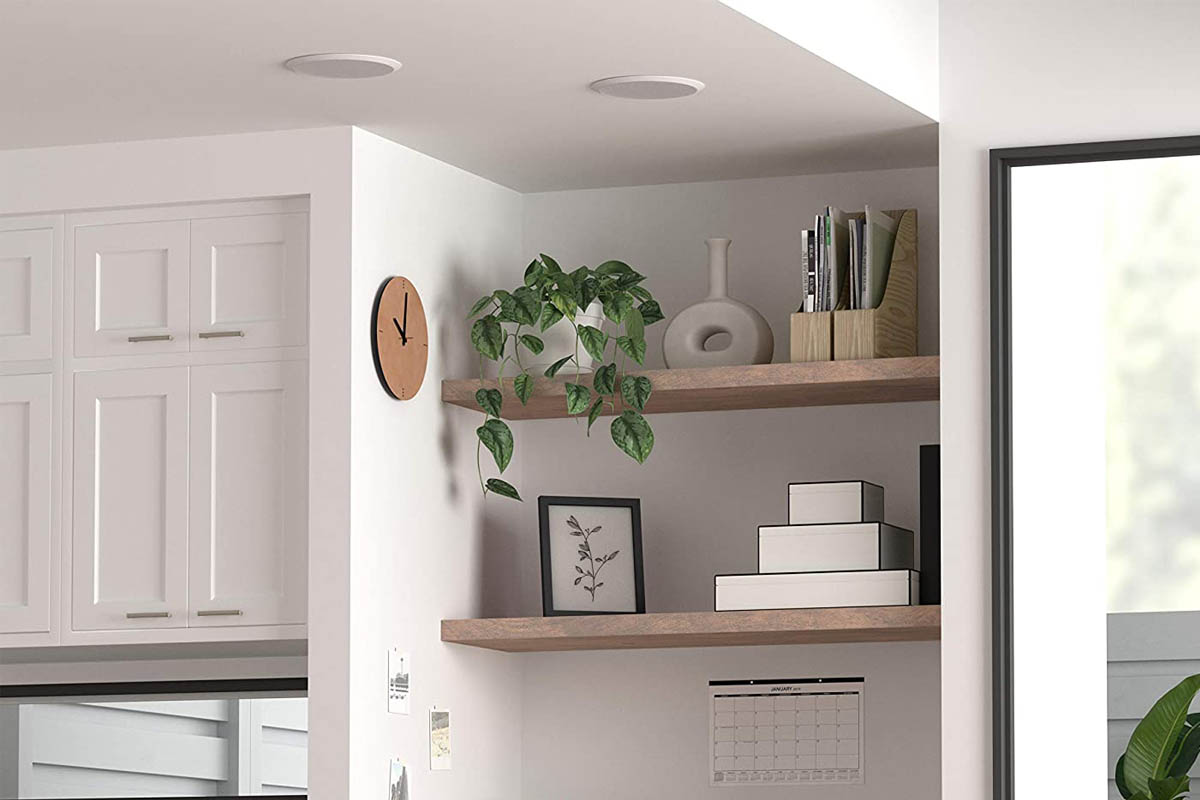
Before You Buy In-Ceiling Speakers
Before shopping for in-ceiling speakers, consider a number of important factors. First, ensure that your ceiling can accommodate speaker installation. If free of obstacles, most drywall ceilings can support speakers. Drop-ceiling panels, however, aren’t usually sturdy enough to support them without extra support.
To determine if obstructions, such as wires, pipes, or insulation, exist in the ceiling, drill a pilot hole and explore the area with a small wire. While many ceilings can hold the weight of a speaker system, units may slip out of place if they aren’t properly mounted. Look for speakers that come with their own mounting system; if not, purchase the mounting brackets separately.
If a DIY speaker installation sounds too complicated to tackle, consider hiring a professional and budget for that cost.
What to Consider When Buying In-Ceiling Speakers
When shopping for the best in-ceiling speakers, evaluate the sound quality, weight, size, depth, and cables of the audio system. Also, keep in mind their intended location as well as the tools necessary for installation.
Audio Quality
Audio quality is the top priority when choosing in-ceiling speakers. Unfortunately, defining the best sound quality often is subjective and depends on a range of factors, such as the installation environment and the audio quality of the media playing at the time. Consider beginning the search with one of the many established brands with a good reputation for audio quality.
The best in-ceiling speakers strike a balance between the upper (treble), mid-range, and lower (bass) frequencies. Most in-ceiling speakers are two-way speakers, which means they have two drivers. A treble driver, usually referred to as a “tweeter,” produces high frequencies, while the bass driver, or “woofer,” produces lower bass frequencies. Both are critical to audio quality.
Smaller speakers are often more rigid and don’t produce the lower frequencies than larger models can handle. Larger speakers typically contain a larger, less rigid woofer to deliver lower frequency sound better. Those who prefer a big booming bass should consider larger speakers.
Size
In-ceiling speakers come in a range of sizes, from small, which range from 3 to 6 inches in diameter, to speakers for medium-to-large spaces that measure from 6.5 to 8 inches. Measurement refers to the diameter of the speaker, not the entire unit. Small speakers, which are easier to hide, are often designed to blend with halogen lights. Once installed, larger speakers are more visible.
Also consider mounting depth. While many speakers need only a few inches of mounting depth, some larger speakers with extra-large woofers may need 8 or more inches.
Speaker Location
Speaker location can make a big difference in the quality of audio in the room. Both the number and placement of speakers usually depend largely on room size and shape. A single speaker in the center of the ceiling should be sufficient for small spaces. For medium or large rooms, consider one or multiple speaker pairs for balanced stereo sound. Place pairs an equal distance apart from each wall and about 6 ½ feet apart.
For rooms frequently exposed to moisture, such as bathrooms and kitchens, choose water- or rust-resistant designs. On some speakers, the tweeter swivels to adjust the direction of sound, which is helpful in unconventional room layouts and to control sound direction.
Cables
In-ceiling speakers must be connected to other devices, such as amplifiers or receivers, with either a CL2 or CL3 UL-rated wire cable of the proper length and connection. Factor the distance the cables must travel once in place (i.e., the length of the wall, around any architectural features, back down the wall, and so on), and add the measurement into the final count to determine the length of the cables. To be safe, buy cables 10 to 15 percent longer than necessary to accommodate unexpected obstacles.
Installation Skills and Tools
Consult the speakers’ instruction manual or packaging for a list of the tools and supplies required. Wiring speaker cable requires access behind the walls and ceiling. Most likely, installation involves the following tools:
- No. 2 pencil with an eraser to mark hole locations
- Multi-head screwdriver
- Measuring tape
- Stud finder to help detect pipes and other obstacles behind the wall or ceiling
- Drill to create a pilot hole and mounting holes
- Jab saw to cut ceiling boards or drywall
Our Top Picks
The following products are considered among the best in-ceiling speakers available, depending upon individual preferences and needs.
Best Overall
Yamaha 140-Watts 2-Way RMS Speaker
See ItThis two-way speaker pair from Yamaha can deliver clear, crisp sound for music or home theater use. The speakers feature an 8-inch polypropylene mica cone woofer and a 1-inch soft-dome swivel tweeter, which is adjustable for precise positioning.
The large mounting clamp grips feature non-slip treads for easy and secure installation. The easy-to-reach magnetic grill can be painted to match the ceiling.
A sealed back cover helps the speaker resist both dust and moisture. Each speaker is almost 11 inches in diameter. This set has a maximum output of 140 watts, but Yamaha offers a 90- and 110-watt option.
Best Upgrade
AmazonBasics 8u0022 Round In-Ceiling In-Wall Speakers
See ItSuitable for ceiling or wall mounting, this set of AmazonBasics two-way speakers is suitable for streaming movies or listening to music. The 8-inch composite woofer and 1-inch high-fidelity ring tweeter offer clear stereo separation.
The set comes with cut-out templates to assist with measuring and placing the speakers during installation. Paint the grilles to match room decor and remove them when cleaning. Painting masks are included to help prevent paint from damaging the speaker cover while painting. Each speaker can handle 20 to 100 watts.
Best Design
Pyle 8u0022 1000W Round Wall And Ceiling Speakers
See ItThese 8-inch midbass speakers create a full sound with directable ½-inch polymer dome tweeters, high-temperature voice coils, and high-efficiency response rates. Each speaker can handle up to 250 watts and can install in either the ceiling or wall.
The set includes cut-out templates to assist when measuring, cutting, and placing the speakers during installation, as well as all the required mounting hardware. The speaker terminals are designed for simple wire connections, making installation easier.
Best Theater
Pyle 6.5u0022 In-Wall/In-Ceiling Midbass Speakers (Pair)
See ItFor the clear, full sound that makes movies and games exciting, consider this pair of Pyle two-way midbass speakers. Each 6.5-inch speaker features directable 1-inch titanium dome tweeters, high-temp voice coils, and high-efficiency response rates.
The speakers have a 250-watt power handling capability. They can be installed in the ceiling or wall to create an immersive soundscape. Each unit has integrated wiring and an amplifier transformer switch to allow hassle-free installation. They feature a flush-mount design for an unobtrusive look.
Top Pick for Easy Install
Polk Audio 2-way Premium In-Ceiling 8u0022 Round Speakers
See ItTo install in-ceiling speakers with minimal muss and fuss, consider this speaker pair from Polk, designed for simple, three-step installation. The speakers feature rotating cams to secure each unit without extra assembly.
Once installed, enjoy the clarity of the system’s 8-inch polymer composite woofer and 1-inch, directable ring-radiator tweeter. A tweeter-level switch allows adjustments for the room’s acoustics.
These two-way speakers can be used in moist environments, such as bathrooms, kitchens, saunas, and covered porches, thanks to a rubber seal that makes them both rust- and moisture-resistant. The grill is paintable to allow color matching.
FAQs About In-Ceiling Speakers
The best in-ceiling speaker systems immerse you in a sonic experience, whether watching movies or listening to music. For more information about in-ceiling speakers and their features, consider the answers to these frequently asked questions.
Q. What’s better, in-wall or in-ceiling speakers?
In-wall speakers are sometimes considered better for home theater because they provide sound at the same level as your ears, offering a more lifelike listening experience. In-ceiling speakers are ideal for multi-room unobtrusive installation to fill a room with immersive sound.
Q. What do ceiling speakers connect to?
In-ceiling speakers typically connect via a speaker cable to an external amplifier. Very few in-ceiling speakers have a built-in amplifier.
Q. How many ceiling speakers do I need?
Two in-ceiling speakers should be sufficient for a room of up to 225 square feet. When planning for larger spaces, events, or more complex sound experiences, you may wish to consult a sound engineer for additional guidance.
